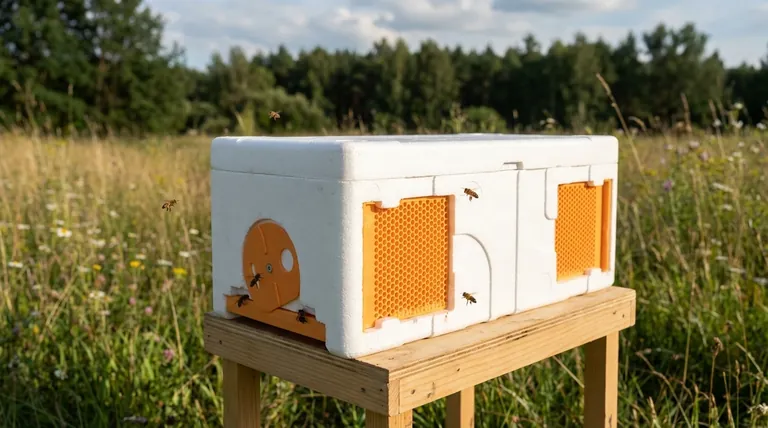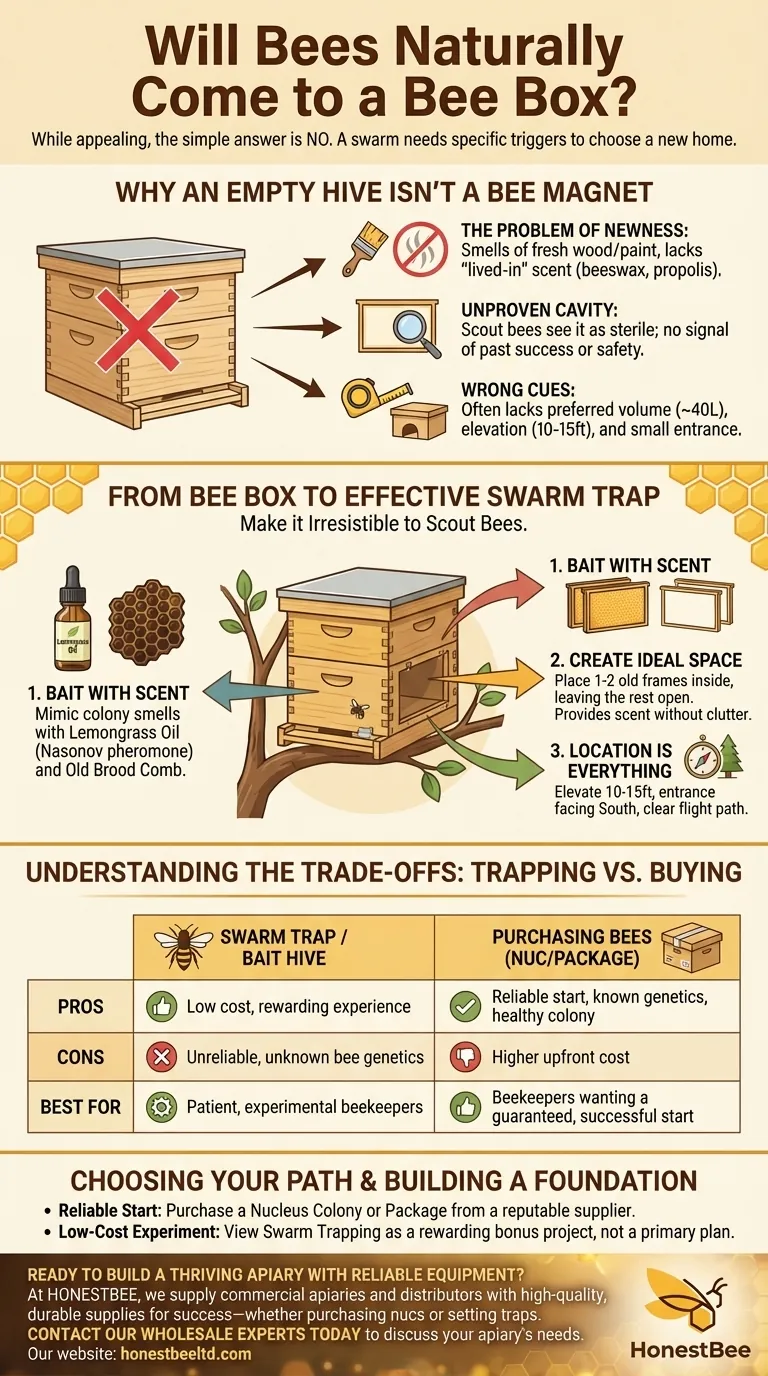While an appealing thought for any new beekeeper, the simple answer is no. A swarm of honeybees will almost never move into an empty, unprepared bee box on its own. Although the box is designed for them, it lacks the specific triggers that scout bees are searching for when seeking a new home.
To successfully establish a colony, you cannot rely on luck. You must either proactively attract a swarm by converting your box into a proper "bait hive" or, more reliably, purchase a starter colony from a reputable bee supplier.

Why an Empty Hive Isn't a Bee Magnet
When a honeybee colony outgrows its home, it creates a new queen and the old queen leaves with roughly half the bees. This traveling group, known as a swarm, temporarily clusters on a branch while scout bees search for a permanent residence. These scouts are incredibly discerning.
The Mind of a Scout Bee
Scout bees do not see an empty box as a perfect home; they see it as a sterile, unproven cavity. They are looking for a location that signals safety, security, and a high probability of survival for their colony.
The Problem of "Newness"
A brand-new hive smells of fresh wood and paint, not of beeswax, propolis, and bee pheromones. This lack of a "lived-in" scent is a major red flag for scout bees, suggesting no other colony has ever successfully lived there.
The Importance of Volume and Location
Scout bees have a preferred cavity size, typically around 40 liters (about the size of one standard deep hive body). More importantly, they prefer locations that are elevated (10-15 feet off the ground) and have a small, defensible entrance, which an open hive box does not provide.
From Bee Box to Effective Swarm Trap
While bees won't come to an empty box, you can dramatically increase your chances by turning that box into a proper swarm trap or bait hive. This involves making the box irresistible to passing scout bees.
Baiting with Scent
The most critical factor is scent. You must add lures that mimic the natural smells of an established colony.
- Lemongrass Essential Oil: This is the most effective and widely used lure. It mimics the Nasonov (or "come hither") pheromone that bees use to orient themselves to the hive entrance. A few drops inside the hive are sufficient.
- Old Brood Comb: If you can acquire a piece of old, dark beeswax comb from another beekeeper, its scent is powerfully attractive to scout bees.
Creating the Ideal Space
To make the box more appealing, place one or two old frames inside, leaving the rest of the space open. This provides a scent signal and a starting point without making the cavity feel too small or cluttered.
Location is Everything
Position your swarm trap in a location scout bees favor. This means securing it 10 to 15 feet up in a tree, with the entrance facing south if possible, and ensuring it has a clear flight path.
Understanding the Trade-offs: Trapping vs. Buying
Even with a perfectly prepared swarm trap, attracting a colony is a game of patience and probability, not a guarantee. You must weigh this approach against the more conventional methods.
The Uncertainty of Trapping
Catching a swarm is not a reliable way to start an apiary on a specific timeline. You could put out a trap and catch a swarm in a week, or you could wait an entire season with no success. It depends entirely on whether a swarm happens to pass through your area.
The Genetics of a Wild Swarm
When you catch a wild swarm, you have no information about its history. The bees could be gentle and productive, or they could be aggressive and prone to disease. It is an unknown variable.
The Reliability of Purchased Bees
The most dependable way to start a beehive is to buy bees. You can purchase a nucleus colony ("nuc"), which is a small, established hive with a laying queen, or a package of bees with a caged queen. This guarantees you will start with a healthy, vetted colony on a predictable schedule.
Choosing Your Path to a First Colony
Your approach should be determined by your primary goal as a beekeeper.
- If your primary focus is a reliable start to beekeeping: Purchase a nucleus colony or a bee package from a reputable local supplier. This is the surest path to a successful first year.
- If your primary focus is a low-cost, patient experiment: Setting up a proper swarm trap is a rewarding and educational project. View it as a bonus, not a primary plan for acquiring your first bees.
Proactively establishing your first colony is the foundational step toward becoming a successful and responsible beekeeper.
Summary Table:
| Method | Pros | Cons | Best For |
|---|---|---|---|
| Swarm Trap / Bait Hive | Low cost, rewarding experience | Unreliable, unknown bee genetics | Patient, experimental beekeepers |
| Purchasing Bees (Nuc/Package) | Reliable start, known genetics, healthy colony | Higher upfront cost | Beekeepers wanting a guaranteed, successful start |
Ready to build a thriving apiary with reliable equipment?
At HONESTBEE, we supply commercial apiaries and beekeeping equipment distributors with the high-quality, durable supplies needed for success—whether you're starting with a purchased nuc or setting up swarm traps. Let us help you build a stronger foundation.
Contact our wholesale experts today to discuss your apiary's needs.
Visual Guide

Related Products
- Twin Queen Styrofoam Honey Bee Nucs Mating and Breeding Box
- 5 Frame Wooden Nuc Box for Beekeeping
- Portable Bee Mating Hive Boxes Mini Mating Nucs 8 Frames for Queen Rearing
- Automatic Heat Preservation 6 Frame Pro Nuc Box for Honey Bee Queen Mating
- Plastic Transporting Bee Packages and Nuc Boxes for Beekeeping
People Also Ask
- What are the benefits of moving nuclei around the apiary? Master Strategic Hive Management
- What are the best times to pick up a nucleus colony? Ensure a Strong Start for Your Apiary
- What are the three key points to understand when making a nucleus? Master Bee Behavior for Success
- What is the purpose of a nucleus colony in beekeeping? Boost Apiary Resilience & Growth
- What role do nuc hives play in queen breeding? Master Efficient Queen Rearing for Your Apiary



















